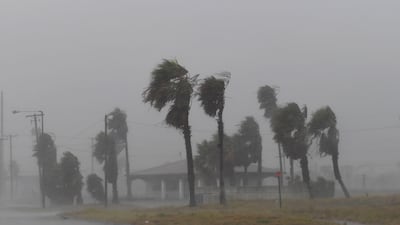One of the worst things that can happen to a wind farm is too much wind.
Hurricane Harvey was packing top winds of 185kph on Saturday, according to a National Hurricane Center advisory. That is more than twice the 88kph speed that prompts many turbines to shut off. The result: the storm could knock out between 2.1 and 3.6 gigawatts of power near the Texas coast, according to Bloomberg New Energy Finance.
Wind-farm operators have been bracing for days. Avangrid, a Connecticut-based power company, evacuated all personnel from its wind farm complex on the South Texas coast, a spokesman said.
“The problem with this hurricane is they don’t see it trailing off in any direction so it’s just going to hover,” said Jeff Ferguson, the Texas-based senior vice president of project development at Apex Clean Energy. “So it could be next week for the winds to diminish adequately so we can resume normal operations.”
_______________
Read more:
Masdar to help build Oman wind farm powering 16,000 homes
Wind speed slows for Vestas’ Q2 profit
Final turbine arrives at Masdar-backed windfarm off Scottish coast
_______________
Production was set to peak in the late afternoon Friday and taper off as turbines automatically begin to shut down, according to Simon Mahan, a director at Southern Wind Energy Association. Turbines generally aren’t designed for hurricane risk, said Alex Morgan, a New York-based analyst at BNEF.
“They’ll pitch down and yaw into the wind, which allows them to safely pinwheel,” said John Martinez, the director of operation at Pattern Energy Group, which owns the 283-megawatt Gulf Wind farm in Kenedy County. “This way the blades don’t flex, which can be damaging. The turbines are designed to automatically do that.”
But even not so powerful wind events can have catastrophic effects in turbines. In 2012 a series of tornadoes hit Kansas with some turbines being practically destroyed.
Wind power may be the least of the Texas region’s power-market worries. If hundreds of thousands of people lose power as is expected, it does not matter whether the wind farms are running or not, because they would have nowhere to send the electricity generated. It is the very reason why power and gas are trading down.
“With gas plentiful and load down, I suspect the lack of wind won’t matter at all,” said Cody Moore, the Houston-based president of BioUrja Group’s power trading division. “I’d be more concerned with the safety of the turbines than any need for load.”
Texas easily boasts the most wind capacity among US states, about 21 gigawatts, or one-quarter of national capacity, according to the American Wind Energy Association. A majority of the wind is located in western Texas, which Genscape expects will not be greatly affected by Harvey.
The 3.6 gigawatts of capacity installed in the south power zone of the Electric Reliability Council of Texas is a different matter. About 2.1 gigawatts is directly along the coast.
“As that storm starts coming onshore, there’s a good chance winds will exceed 55 miles per hour [88kph],” Michaella Farese, a Boston-based meteorologist and demand forecaster at Genscape, said on Friday.

